Prince Henry of Prussia (1862–1929)
| Prince Henry of Prussia | |||||
|---|---|---|---|---|---|
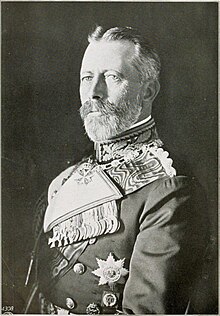 | |||||
| Born | August 14, 1862 Berlin, Kingdom of Prussia | ||||
| Died | April 20, 1929 (aged 66) Schloss Hemmelmark, Barkelsby, Schleswig-Holstein, Weimar Republic | ||||
| Burial | 24 April 1929 Schloss Hemmelmark, Barkelsby, Schleswig-Holstein, Germany | ||||
| Spouse | |||||
| Issue | Prince Waldemar Prince Sigismund Prince Henry | ||||
| |||||
| House | Hohenzollern | ||||
| Father | Frederick III, German Emperor | ||||
| Mother | Victoria, Princess Royal | ||||
| Military career | |||||
| Service/ | |||||
| Years of service | 1872–1919 | ||||
| Rank | Großadmiral (grand admiral) | ||||
| Commands held |
| ||||
| Awards |
| ||||
| Prussian Royalty |
| House of Hohenzollern |
|---|
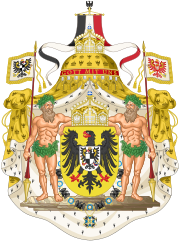 |
| Frederick III |
|
Prince Albert William Henry of Prussia (German: Albert Wilhelm Heinrich; 14 August 1862 – 20 April 1929) was a younger brother of German Emperor William II and a Prince of Prussia. He was also a grandson of Queen Victoria. A career naval officer, he held various commands in the Imperial German Navy and eventually rose to the rank of Grand Admiral and Generalinspekteur der Marine.
Biography[]
Born in Berlin, Prince Henry was the third child and second son of eight children born to Crown Prince Frederick (later Emperor Frederick III), and Victoria, Princess Royal of the United Kingdom (later Empress Victoria and in widowhood Empress Frederick), eldest daughter of the British Queen Victoria. Henry was three years younger than his brother, the future Emperor William II (born 27 January 1859). He was born on the same day as King Frederick William I "Soldier-King" of Prussia.
After attending the gymnasium in Kassel, which he left in the middle grades in 1877, the 15-year-old Henry entered the Imperial Navy cadet program. His naval education included a two-year voyage around the world (1878 to 1880), the naval officer examination (Seeoffizierhauptprüfung) in October 1880, and attending the German naval academy (1884 to 1886).

Early commands[]
As an imperial prince, Henry quickly achieved command. In 1887, he commanded a torpedo boat and simultaneously the First Torpedo Boat Division; in 1888 the Imperial yacht SMY Hohenzollern; from 1889 to 1890 the second-class cruiser SMS Irene, the armored coastal defense ship SMS Beowulf, and the capital ships SMS Sachsen and SMS Wörth.
Squadron commands[]
From 1897, Prince Henry commanded several naval task forces; these included an improvised squadron that took part with the East Asia Squadron in consolidating and securing the German hold on the region of Kiaochow and the port of Tsingtao in 1898. The prince’s success was more of the diplomatic than the military variety; he became the first European potentate ever to be received at the Chinese imperial court. In 1899 he became officially the commander of the East Asia Squadron, later of a capital-ship squadron and in 1903 commander of the Baltic Sea naval station. From 1906 to 1909, Henry was commander of the High Seas Fleet. In 1909, he was promoted to Grand Admiral.[citation needed]
World War I[]


At the beginning of World War I, Prince Henry was named Commander-in-Chief of the Baltic Fleet. Although the means provided to him were far inferior to Russia's Baltic Fleet, he succeeded, until the 1917 Revolution, in putting Russian naval forces far on the defensive and hindered them from making attacks on the German coast. After the end of hostilities with Russia, his mission was ended, and Prince Henry simply left active duty. With the war’s end and the dissolution of the monarchy in Germany, Prince Henry left the navy.
Family[]
On 24 May 1888, Henry married Princess Irene of Hesse and by Rhine, his first cousin. His dying father, German Emperor Frederick III and his mother Empress Victoria were in attendance. The marriage produced three children:
| Name | Picture | Birth | Death | Notes |
|---|---|---|---|---|
| Waldemar William Louis Frederick Victor Henry | 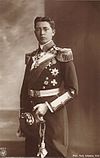 |
20 March 1889 | 2 May 1945 | Married , but had no issue. |
| William Victor Charles Augustus Henry Sigismund | 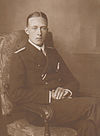 |
27 November 1896 | 14 November 1978 | Married Princess Charlotte of Saxe-Altenburg, had issue. |
| Henry Victor Louis Frederick | 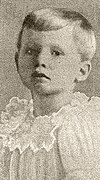 |
9 January 1900 | 26 February 1904 | Was a haemophiliac and died aged four after bumping his head[citation needed] |

Their sons Waldemar and Heinrich were both hemophiliacs, a disease which they inherited through Irene from the maternal grandmother of both of their parents, Queen Victoria, who was a carrier.
Personality and private life[]
Henry received one of the first pilot’s licenses in Germany, and was judged a spirited and excellent seaman. He was dedicated to modern technology and was able to understand quickly the practical value of technical innovations. A yachting enthusiast, Prince Henry became one of the first members of the Yacht Club of Kiel, established by a group of naval officers in 1887, and quickly became the club's patron.
Henry was interested in motor cars as well and supposedly invented a windshield wiper[1] and, according to other sources, the car horn.
In his honor, the Prinz-Heinrich-Fahrt (Prince Heinrich Tour) was established in 1908, like the earlier Kaiserpreis a precursor to the German Grand Prix. Henry and his brother William gave patronage to the Kaiserlicher Automobilclub (Imperial Automobile Club). From 1911 to 1914 the British car makers Vauxhall Motors produced a model, the C-10, which was called the "Vauxhall Prince Henry" in his honour after initially being built for participation in the 1911 race.
After the German Revolution, Henry lived with his family in near Eckernförde, in Schleswig-Holstein. He continued with motor sports and sailing and even in old age was a very successful participant in regattas. He popularized the Prinz-Heinrich-Mütze ("Prince Henry cap"), which is still worn, especially by older sailors.
In 1899, Henry received an honorary doctorate (Doctor of Engineering honoris causa) from the Technical University of Berlin. Also in foreign countries he received numerous similar honors, including an honorary doctorate (LL.D.) from Harvard University in March 1902, during his visit to the United States.[2]
Prince Henry died of throat cancer, as his father had, in Hemmelmark on 20 April 1929.[3]
George Burroughs Torrey painted a portrait of him.
[]
- Unterleutnant zur See, 14 August 1872; Basic Training and Naval Academy 1877-1878
- Leutnant zur See, 18 October 1881; Training Cruises and Naval Academy 1878-1882
- Kapitänleutnant, 18 October 1884; Executive Officer, Armored Cruiser SMS Oldenburg, 1886
- Korvettenkapitän, 18 October 1887; Commander, 1st Torpedo Boat Division, 1887; Commander, Imperial Yacht SMY Hohenzollern, 1888
- Kapitän zur See, 27 January 1889; Commander, Cruiser SMS Irene, 1889–1890; Commander, Armored Coastal Defense Ship SMS Beowulf, 1892; Commander, Armored Cruiser SMS Sachsen, 1892–1894; Commander, Armored Ship of the Line SMS Wörth, 1894–1895
- Konteradmiral, 15 September 1895; Commander, 2nd Division, 1st Battle Squadron, 1896–1897; Commander, 2nd Division, Cruiser Squadron, 1897–1899
- Vizeadmiral, 5 December 1899; Commander, Cruiser Squadron, 1899–1900; Commander, 1st Battle Squadron, 1900–1903
- Admiral, 13 September 1901;[4] Commanding Admiral, Baltic Sea Naval Command, 1903–1906, Commander, High Seas Fleet, 1906–1909
- Großadmiral, 4 September 1909; Inspector General of the Imperial Navy, 1909–1918; Commander-in-Chief, Baltic Fleet, 1914–1918
Regimental commissions and honorary ranks[]
German[]
- 1. Garde-Regiment zu Fuß (Royal Prussian 1st Regiment of Foot Guards) – Leutnant (Second Lieutenant) through Generaloberst im Range eines Generalfeldmarschalls (Colonel-General in the Rank of Field Marshal), 1871 - 1918[5]
- Kgl. Sächs. 2. Grenadier-Regiment Kaiser Wilhelm, König von Preußen Nr. 101 (Royal Saxon 2nd Grenadier Regiment)
- Kgl. Bayerisches Artillerie-Regiment Nr. 8 (Royal Bavarian 8th Artillery Regiment) – Generaloberst im Range eines Generalfeldmarschalls and Chef (Colonel in Chief)[6]
- 1. Großherzogl. Hessisches Feldartilleree-Regiment 25 (Grand Duchy of Hesse 2nd Artillery Regiment)[5]
- Fußilier-Regiment “Prinz Heinrich von Preußen” (Brandenburgisches) Nr 35 (The Brandenburg Fusilier Regiment) - Generaloberst im Range eines Generalfeldmarschalls and Chef (Colonel in Chief)[7]
Foreign[]
 Austria-Hungary: K.u.K. Infantry Regiment Nr. 20 – Oberstinhaber (Colonel in Chief)[5]
Austria-Hungary: K.u.K. Infantry Regiment Nr. 20 – Oberstinhaber (Colonel in Chief)[5] Austria-Hungary: K.u.K. Kriegsmarine (Navy) – Vizeadmiral (vice admiral)[5]
Austria-Hungary: K.u.K. Kriegsmarine (Navy) – Vizeadmiral (vice admiral)[5]
- Austria-Hungary: K.u.K. Kriegsmarine - Konteradmiral (rear-admiral) 1899[8]
 United Kingdom: Royal Navy – Admiral (Honorary) 13 September 1901[4][5]
United Kingdom: Royal Navy – Admiral (Honorary) 13 September 1901[4][5]
- Royal Navy - Vice-Admiral (Honorary) 5 February 1901.[9]
 Russian Empire: Imperial Dragoon Regiment Nr. 33 – Colonel[5]
Russian Empire: Imperial Dragoon Regiment Nr. 33 – Colonel[5]
Honours[]
 Prussia:
Prussia:
- Knight of the Black Eagle, 14 August 1872; with Collar, 1881[11]
- Grand Cross of the Red Eagle, 1872
- Knight of the Crown Order, 1st Class, 14 August 1872[11]
- Grand Commander's Cross of the Royal House Order of Hohenzollern, 14 August 1872[11]
- Knight of Justice of the Johanniter Order[12]
- Long Service Award
- Pour le Mérite (military), 1 August 1916; with Oak Leaves, 24 January 1918[13]
 Hohenzollern: Cross of Honour of the Princely House Order of Hohenzollern, 1st Class
Hohenzollern: Cross of Honour of the Princely House Order of Hohenzollern, 1st Class Anhalt: Grand Cross of the Order of Albert the Bear, 1884[14]
Anhalt: Grand Cross of the Order of Albert the Bear, 1884[14] Baden:[15]
Baden:[15]
- Knight of the House Order of Fidelity, 1881
- Knight of the Order of Berthold the First, 1881
 Bavaria: Knight of St. Hubert, 1886[12][16]
Bavaria: Knight of St. Hubert, 1886[12][16] Brunswick: Grand Cross of the Order of Henry the Lion, 1888[17]
Brunswick: Grand Cross of the Order of Henry the Lion, 1888[17]

 Ernestine duchies: Grand Cross of the Saxe-Ernestine House Order, 1885[18]
Ernestine duchies: Grand Cross of the Saxe-Ernestine House Order, 1885[18]

 Free Hanseatic Cities: Hanseatic Crosses
Free Hanseatic Cities: Hanseatic Crosses Hesse and by Rhine:
Hesse and by Rhine:
- Grand Cross of the Ludwig Order, 1 April 1875[19]
- Knight of the Golden Lion, with Collar, 24 May 1888[19]
- Medal of Bravery
 Mecklenburg: Grand Cross of the Wendish Crown, with Crown in Ore and Diamonds
Mecklenburg: Grand Cross of the Wendish Crown, with Crown in Ore and Diamonds Oldenburg: Grand Cross of the Order of Duke Peter Friedrich Ludwig, with Golden Crown, 18 February 1878[20]
Oldenburg: Grand Cross of the Order of Duke Peter Friedrich Ludwig, with Golden Crown, 18 February 1878[20] Saxe-Weimar-Eisenach: Grand Cross of the White Falcon, 1882[21]
Saxe-Weimar-Eisenach: Grand Cross of the White Falcon, 1882[21] Saxony:
Saxony:
- Knight of the Rue Crown, 1882[22]
- Grand Cross of the Albert Order, with Crown and Swords
 Württemberg: Grand Cross of the Württemberg Crown, 1882[23]
Württemberg: Grand Cross of the Württemberg Crown, 1882[23]
- Foreign[5]

 Austria-Hungary: Grand Cross of the Royal Hungarian Order of St. Stephen, 1872[24]
Austria-Hungary: Grand Cross of the Royal Hungarian Order of St. Stephen, 1872[24] Belgium: Grand Cordon of the Order of Leopold
Belgium: Grand Cordon of the Order of Leopold Brazil: Grand Cross of the Southern Cross
Brazil: Grand Cross of the Southern Cross Bulgaria: Grand Cross of St. Alexander
Bulgaria: Grand Cross of St. Alexander China: Order of the Double Dragon, Class I Grade II
China: Order of the Double Dragon, Class I Grade II Denmark: Knight of the Elephant, 30 July 1888[25]
Denmark: Knight of the Elephant, 30 July 1888[25] Finland: Grand Cross of the Cross of Liberty, 1918[26]
Finland: Grand Cross of the Cross of Liberty, 1918[26] Greece: Grand Cross of the Redeemer
Greece: Grand Cross of the Redeemer Hawaii: Grand Cross of the Order of Kalākaua
Hawaii: Grand Cross of the Order of Kalākaua Italy:
Italy:
- Knight of the Annunciation, 18 October 1875[27]
- Grand Cross of Saints Maurice and Lazarus, 18 October 1875
 Tuscan Grand Ducal family: Grand Cross of St. Joseph
Tuscan Grand Ducal family: Grand Cross of St. Joseph
 Holy See: Knight of the Supreme Order of Christ
Holy See: Knight of the Supreme Order of Christ Japan: Grand Cordon of the Order of the Chrysanthemum, 10 June 1879[28]
Japan: Grand Cordon of the Order of the Chrysanthemum, 10 June 1879[28] Korea: Grand Cordon of the Order of the Golden Ruler, 1904[29]
Korea: Grand Cordon of the Order of the Golden Ruler, 1904[29] Montenegro: Grand Cross of the Order of Prince Danilo I
Montenegro: Grand Cross of the Order of Prince Danilo I Netherlands: Grand Cross of the Netherlands Lion
Netherlands: Grand Cross of the Netherlands Lion Ottoman Empire: Order of Osmanieh, 1st Class with Diamonds
Ottoman Empire: Order of Osmanieh, 1st Class with Diamonds Portugal:
Portugal:
- Grand Cross of the Sash of the Two Orders
- Grand Cross of the Tower and Sword
 Romania: Grand Cross of the Star of Romania
Romania: Grand Cross of the Star of Romania Russia:
Russia:
- Knight of St. Andrew[12]
- Knight of St. Alexander Nevsky
- Knight of the White Eagle
- Knight of St. Anna, 1st Class
- Knight of St. Stanislaus, 1st Class
 Serbia: Grand Cross of the White Eagle
Serbia: Grand Cross of the White Eagle Siam: Knight of the Order of the Royal House of Chakri, 24 December 1899[30]
Siam: Knight of the Order of the Royal House of Chakri, 24 December 1899[30] Spain:
Spain:
- Knight of the Golden Fleece, 3 October 1883[31]
- Grand Cross of Naval Merit, with White Decoration, 1903[32]

 Sweden-Norway:
Sweden-Norway:
- Knight of the Seraphim, 17 October 1887[33]
- Grand Cross of St. Olav, with Collar, 1 August 1888[34]
 United Kingdom:
United Kingdom:
- Honorary Grand Cross of the Bath (civil), 13 August 1881[35] (expelled in 1915)
- Stranger Knight of the Garter, 8 August 1889[36] (expelled in 1915)
- Royal Victorian Chain, 9 August 1902[37] (expelled in 1915)
 Venezuela: Collar of the Order of the Liberator
Venezuela: Collar of the Order of the Liberator
Honorary degrees and offices[]
- Freedom of the City of New York, 25 February 1902, during his visit to the city.[38]
- Freedom of the City of Philadelphia, 10 March 1902, during his visit to the city.[39]
- Honorary doctorate (LL.D.) from Harvard University, 6 March 1902.[2]
Ancestry[]
| Ancestors of Prince Henry of Prussia (1862–1929) | |||||||||||||||||||||||||||||||||||||||||||||||||||||||||||||||||||||||||||||||||||||||||||||||||||||||||||||||||||||||||||||||||||||||||||||||||||||||||||||||||||||||||||||||||||||||||||||||||||||||||||||||||||||||||||||||||||||||||||||||||||||||||||||||||||||||||||||||||||||||||
|---|---|---|---|---|---|---|---|---|---|---|---|---|---|---|---|---|---|---|---|---|---|---|---|---|---|---|---|---|---|---|---|---|---|---|---|---|---|---|---|---|---|---|---|---|---|---|---|---|---|---|---|---|---|---|---|---|---|---|---|---|---|---|---|---|---|---|---|---|---|---|---|---|---|---|---|---|---|---|---|---|---|---|---|---|---|---|---|---|---|---|---|---|---|---|---|---|---|---|---|---|---|---|---|---|---|---|---|---|---|---|---|---|---|---|---|---|---|---|---|---|---|---|---|---|---|---|---|---|---|---|---|---|---|---|---|---|---|---|---|---|---|---|---|---|---|---|---|---|---|---|---|---|---|---|---|---|---|---|---|---|---|---|---|---|---|---|---|---|---|---|---|---|---|---|---|---|---|---|---|---|---|---|---|---|---|---|---|---|---|---|---|---|---|---|---|---|---|---|---|---|---|---|---|---|---|---|---|---|---|---|---|---|---|---|---|---|---|---|---|---|---|---|---|---|---|---|---|---|---|---|---|---|---|---|---|---|---|---|---|---|---|---|---|---|---|---|---|---|---|---|---|---|---|---|---|---|---|---|---|---|---|---|---|---|---|---|---|---|---|---|---|---|---|---|---|---|---|---|---|---|---|
| |||||||||||||||||||||||||||||||||||||||||||||||||||||||||||||||||||||||||||||||||||||||||||||||||||||||||||||||||||||||||||||||||||||||||||||||||||||||||||||||||||||||||||||||||||||||||||||||||||||||||||||||||||||||||||||||||||||||||||||||||||||||||||||||||||||||||||||||||||||||||
References[]
- ^ "untitled". The Day Book. Chicago. June 13, 1914. p. 10. Retrieved August 20, 2014.
Admiral Prince Henry of Prussia, brother of the kaiser, has invented and patented an electrical device for cleaning windows of automobiles in rainy or frosty weather. The device is set in operation by the pressing of a button.
- ^ a b "Latest intelligence - Prince Henry in America". The Times (36709). London. 7 March 1902. p. 3.
- ^ "Died". Time. 29 April 1929. Archived from the original on October 24, 2012. Retrieved 2008-06-06.
Prince Henry of Hohenzollern, 66, of Berlin, brother of onetime Kaiser Wilhelm II, Wartime commander of Germany's Baltic fleet; of heart disease and pneumonia; in Berlin. Popular Prince Henry visited the U. S. in 1884 and 1902, was caricatured in many a newspaper passing under festal arches of sausages, pretzels.
- ^ a b "No. 27365". The London Gazette. 15 October 1901. p. 6711.
- ^ a b c d e f g h Handbuch über den Königlich Preussischen Hof und Staat, 1908, p. 2
- ^ Der Rittmeister Militaria, LLC: http://www.derrittmeister.com/royalty.htm
- ^ Handbuch..., 1908, p. 2, and Der Rittmeister Militaria, LLC: http://www.derrittmeister.com/royalty.htm
- ^ "The Triple Alliance". The Times (36062). London. 10 February 1900. p. 7.
- ^ "No. 27281". The London Gazette. 5 February 1901. p. 766.
- ^ Handbuch über den Königlich Preußischen Hof und Staat (1918), Genealogy p. 3
- ^ a b c Königlich Preussische Ordensliste (in German), 1, Berlin, 1886, pp. 7, 552, 934 – via hathitrust.org
- ^ a b c Justus Perthes, Almanach de Gotha (1914) p. 71
- ^ "Albert Wilhelm Heinrich Prinz von Preußen, K.H." the Prussian Machine. Archived from the original on 2017-10-23. Retrieved 7 August 2020.
- ^ Hof- und Staats-Handbuch für des Herzogtum Anhalt (1894), "Herzoglicher Haus-Orden Albrecht des Bären" p. 17
- ^ Hof- und Staats-Handbuch des Großherzogtum Baden (1888), "Großherzogliche Orden" pp. 61, 73
- ^ Hof- und Staats-Handbuch des Königreichs Bayern (1906), "Königliche-Orden" p. 8
- ^ Hof- und Staatshandbuch des Herzogtums Braunschweig für das Jahr 1897, "Herzogliche Orden Heinrich des Löwen" p. 10
- ^ Staatshandbücher für das Herzogtum Sachsen-Coburg und Gotha (1890), "Herzogliche Sachsen-Ernestinischer Hausorden" p. 46
- ^ a b Großherzoglich Hessische Ordensliste (in German), Darmstadt: Staatsverlag, 1914, pp. 2, 5 – via hathitrust.org
- ^ Hof- und Staatshandbuch des Großherzogtums Oldenburg0: 1879. Schulze. 1879. p. 34.
- ^ Staatshandbuch für das Großherzogtum Sachsen / Sachsen-Weimar-Eisenach (1900), "Großherzogliche Hausorden" p. 16
- ^ Sachsen (1901). "Königlich Orden". Staatshandbuch für den Königreich Sachsen: 1901. Dresden: Heinrich. p. 4 – via hathitrust.org.
- ^ Hof- und Staats-Handbuch des Königreich Württemberg (1907), "Königliche Orden" p. 27
- ^ "A Szent István Rend tagjai" Archived 22 December 2010 at the Wayback Machine
- ^ Jørgen Pedersen (2009). Riddere af Elefantordenen, 1559–2009 (in Danish). Syddansk Universitetsforlag. p. 468. ISBN 978-87-7674-434-2.
- ^ Tom C. Bergroth (1997). Vapaudenristin ritarikunta: Isänmaan puolesta (in Finnish). Werner Söderström Osakeyhtiö. p. 65. ISBN 951-0-22037-X.
- ^ Italia : Ministero dell'interno (1898). Calendario generale del Regno d'Italia. Unione tipografico-editrice. p. 54.
- ^ 刑部芳則 (2017). 明治時代の勲章外交儀礼 (PDF) (in Japanese). 明治聖徳記念学会紀要. p. 143.
- ^ "조선왕조실록".
- ^ Royal Thai Government Gazette (24 December 1899). "การรับฮิสรอแยลไฮเนส ปรินศเฮนรี สมเด็จพระเจ้าน้องยาเธอ กรุงปรุสเซีย" (PDF) (in Thai). Retrieved 2019-05-08. Cite journal requires
|journal=(help) - ^ "Caballeros de la insigne orden del toisón de oro". Guía Oficial de España (in Spanish). 1887. p. 147. Retrieved 21 March 2019.
- ^ "Caballeros Grandes Cruces de la Orden del Mérito Naval". Guía Oficial de España (in Spanish). 1908. p. 546. Retrieved 14 May 2020.
- ^ Sveriges statskalender (in Swedish), 1925, p. 807, retrieved 2018-01-06 – via runeberg.org
- ^ "Den kongelige norske Sanct Olavs Orden", Norges Statskalender (in Norwegian), 1908, p. 869-870, retrieved 17 September 2021
- ^ Shaw, Wm. A. (1906) The Knights of England, I, London, p. 211
- ^ Shaw, p. 68
- ^ Shaw, p. 416
- ^ "Prince Henry in America". The Times (36701). London. 26 February 1902. p. 5.
- ^ "Latest intelligence - Prince Henry in America". The Times (36712). London. 11 March 1902. p. 5.
Further reading[]
- Harald Eschenburg. Prinz Heinrich von Preußen - Der Großadmiral im Schatten des Kaisers. Heide, 1989, ISBN 3-8042-0456-2. [Translation of title: Prince Heinrich of Prussia - The Grand Admiral in the Shadow of the Emperor.]
- John Van der Kiste. Prince Henry of Prussia. 2015
External links[]
| Wikimedia Commons has media related to Prince Henry of Prussia (1862–1929). |
- 1862 births
- 1929 deaths
- Military personnel from Berlin
- People from the Province of Brandenburg
- Grand admirals of the Imperial German Navy
- Prussian princes
- Naval aviators
- Colonel generals of Prussia
- 19th-century Prussian military personnel
- Sons of emperors
- Deaths from esophageal cancer
- German military personnel of World War I
- German expatriates in China
- Deaths from cancer in Germany
- Recipients of the Pour le Mérite (military class)
- Grand Crosses of the Order of Saint Stephen of Hungary
- Knights of the Golden Fleece of Spain
- Grand Crosses of Naval Merit
- Knights Grand Cross of the Royal Order of Kalākaua
- Knights Grand Cross of the Order of Saints Maurice and Lazarus
- Grand Crosses of the Order of the Star of Romania
- Grand Crosses of the Order of Christ (Portugal)
- Grand Crosses of the Order of Aviz
- Recipients of the Order of the White Eagle (Russia)
- Recipients of the Order of Saint Stanislaus (Russian), 1st class
- Recipients of the Order of St. Anna, 1st class
- Knights of the Order of Saint Joseph
- Honorary Knights Grand Cross of the Order of the Bath
- Extra Knights Companion of the Garter
- Recipients of the Order of the Netherlands Lion